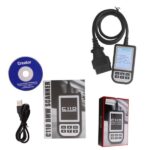Obd2 Diagnose, short for On-Board Diagnostics II, is a standardized system that allows you to access your vehicle’s health information. This system monitors various components impacting emissions and overall performance, providing valuable insights for both car owners and mechanics. Understanding how OBD2 diagnose works can empower you to address car problems efficiently and potentially save on repair costs.
How OBD2 Diagnose Works
OBD2 diagnose utilizes a standardized connector, typically located under the dashboard on the driver’s side. This connector allows a scan tool to communicate with the vehicle’s onboard computer, retrieving diagnostic trouble codes (DTCs). These codes pinpoint specific malfunctions within the system. When an issue is detected, the “Check Engine” light illuminates on your dashboard, signaling the need for an OBD2 diagnose.
Decoding the Check Engine Light with OBD2 Diagnose
The dreaded “Check Engine” light can indicate a range of problems, from minor issues like a loose gas cap to more serious engine malfunctions. OBD2 diagnose provides the key to understanding the underlying cause. By connecting a scan tool, you can retrieve the DTCs stored in the car’s computer. These codes correspond to specific problems, allowing you to narrow down the source of the issue. Online resources and repair manuals can help you decipher the meaning of each code.
Benefits of Using OBD2 Diagnose
- Early Problem Detection: OBD2 diagnose can identify issues before they escalate into major and costly repairs.
- Accurate Diagnosis: DTCs provide precise information, leading to efficient troubleshooting and repair.
- Cost Savings: By understanding the problem, you can avoid unnecessary repairs and potentially negotiate better prices.
- Improved Vehicle Performance: Addressing issues detected through OBD2 diagnose can enhance fuel efficiency and overall performance.
- Empowered Car Owners: OBD2 diagnose equips car owners with the knowledge to make informed decisions about their vehicle’s maintenance.
OBD2 Diagnose vs. OBD I
OBD2 diagnose represents a significant advancement over its predecessor, OBD I. OBD I systems were limited in their diagnostic capabilities, only monitoring a few emission-related components. OBD2 diagnose, mandated for vehicles manufactured since 1996 (gasoline) and 1997 (diesel), provides comprehensive monitoring of virtually all emission-related systems and often includes diagnostics for other vehicle components. This broader scope allows for more thorough and accurate diagnoses.
OBD2 Diagnose and Smog Checks
OBD2 diagnose plays a crucial role in smog checks. During inspections, technicians use scan tools to check for stored DTCs and verify the functionality of the OBD2 system. If the system detects a problem, or if readiness indicators show incomplete diagnostic cycles, the vehicle may fail the inspection.
The Future: OBD III and Remote Diagnostics
While not yet implemented, OBD III envisions remote diagnostics, potentially transmitting OBD data wirelessly for off-site monitoring. This could revolutionize vehicle maintenance and emissions testing.
Conclusion
OBD2 diagnose has transformed car repair, empowering both car owners and mechanics with invaluable diagnostic capabilities. By understanding how to utilize this system, you can gain greater control over your vehicle’s maintenance, potentially saving time and money while ensuring optimal performance. Regularly checking for DTCs with a scan tool and promptly addressing any issues can contribute to a healthier and longer-lasting vehicle. If the “Check Engine” light illuminates, don’t panic – use OBD2 diagnose to understand the problem and take appropriate action.
